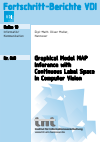Graphical Model MAP Inference with Continuous Label Space in Computer Vision
Zusammenfassung
This thesis deals with monocular object tracking from video sequences. The goal is to improve tracking of previously unseen non-rigid objects under severe articulations without relying on prior information such as detailed 3D models and without expensive offline training with manual annotations. The proposed framework tracks highly articulated objects by decomposing the target object into small parts and apply online tracking. Drift, which is a fundamental problem of online trackers, is reduced by incorporating image segmentation cues and by using a novel global consistency prior. Joint tracking and segmentation is formulated as a high-order probabilistic graphical model over continuous state variables. A novel inference method is proposed, called S-PBP, combining slice sampling and particle belief propagation. It is shown that slice sampling leads to fast convergence and does not rely on hyper-parameter tuning as opposed to competing approaches based on Metropolis-Hastings or heuristi...
Schlagworte
- I–XIV
- 1–14 1 Introduction 1–14
- 1.1 Motivation
- 1.2 Contributions
- 1.3 Structure of the thesis
- 1.4 List of Publications
- 15–24 2 Related Work 15–24
- 2.1 Object Tracking
- 2.2 Approximate MAP Inference in Probabilistic Graphical Models
- 25–55 3 Fundamentals 25–55
- 3.1 Notations
- 3.2 Probabilistic Graphical Models
- 3.2.1 Bayes Network
- 3.2.2 Markov RandomField
- 3.2.3 Factor Graph
- 3.3 Inference in Probabilistic Graphical Models
- 3.3.1 Max-Product Belief Propagation
- 3.3.2 Max-Product Loopy Belief Propagation
- 3.3.3 DualMethods
- 3.4 Markov ChainMonte-CarloMethods
- 3.4.1 Metropolis-Hastings Sampler
- 3.4.2 Gibbs Sampler
- 3.4.3 Slice Sampler
- 3.5 Max-Product Particle Belief Propagation
- 56–77 4 Stochastic Inference in Probabilistic Graphical Models 56–77
- 4.1 Slice-Sampling Particle Max-Product
- 4.1.1 Sampling from Product-Max Distributions
- 4.1.2 ParticleMax-Product
- 4.1.3 Computing the Slice Regions
- 4.1.4 RandomWalk Analysis
- 4.2 Tree-Reweighted ParticleMax-Product
- 4.2.1 Diverse Particle Selection
- 4.2.2 Heuristic Proposals versus Slice-Sampling
- 4.3 Discussion
- 78–106 5 Tracking 78–106
- 5.1 Part-Based Template Tracking
- 5.1.1 Inference
- 5.1.2 Experiments
- 5.1.3 Discussion
- 5.2 Object Tracking Demonstrator
- 5.3 Joint Tracking and Segmentation
- 5.3.1 Joint Pose Estimation and Segmentation
- 5.3.2 Dual Decomposition
- 5.3.3 Visibility Estimation
- 5.3.4 Experiments
- 5.3.5 Summary
- 107–110 6 Conclusions 107–110
- 6.1 FutureWork
- 111–127 A Appendix 111–127
- A.1 Optical Coherence Tomography
- A.1.1 ProblemSetup
- A.1.2 Motion Compensation
- A.1.3 OCT Image Undistortion
- 128–146 Bibliography 128–146


